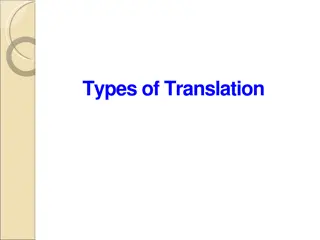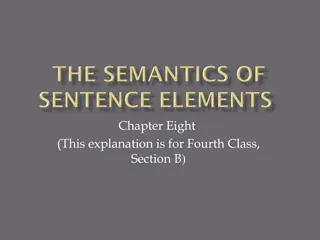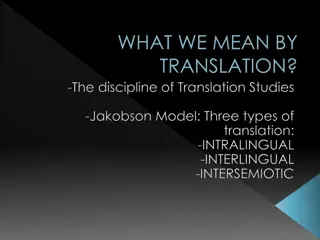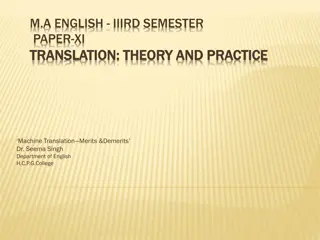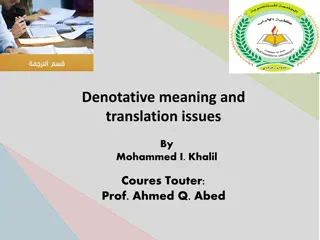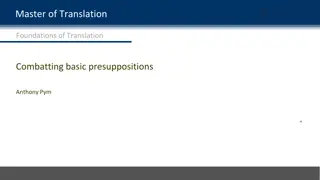Annotating Semantic Issues in Translation for Students
This chapter delves into semantic issues in translation, aiming to assist students in annotating their translations from a semantic viewpoint. It emphasizes using semantic information to aid in translating data accurately while maintaining communicative effectiveness. The story discussed highlights themes of injustice and oppression, challenging translators to capture the essence of the text while preserving its impact on the audience.
Download Presentation

Please find below an Image/Link to download the presentation.
The content on the website is provided AS IS for your information and personal use only. It may not be sold, licensed, or shared on other websites without obtaining consent from the author.If you encounter any issues during the download, it is possible that the publisher has removed the file from their server.
You are allowed to download the files provided on this website for personal or commercial use, subject to the condition that they are used lawfully. All files are the property of their respective owners.
The content on the website is provided AS IS for your information and personal use only. It may not be sold, licensed, or shared on other websites without obtaining consent from the author.
E N D
Presentation Transcript
ANNOTATING SEMANTIC ISSUES (CHAPTER 12) OF SEMANTICS FOR TRANSLATION STUDENTS ARABIC ENGLISH ARABIC BY ALI ALMANNA BY: Nahid Abdul Sahib
Aim of research The aim of this chapter is to the semantic issues to the actual act of translating by consolidating theoretical claims with authentic translational data, thus helping translation students annotate their own translations from a semantic perspective. To achieve this ,a text (386 words) is translated and annotated from a semantic perspective. What is a semantic perspective. It is the process of using semantic information to aid in the translation of data in one representation or data model to another representation or data model. Semantic translation takes advantage of semantics that associate meaning with individual data elements in one dictionary to create an equivalent meaning in a second system.
What is a semantic perspective Note: Semantics is the study of reference, meaning, or truth. The term can be used to refer to subfields of several distinct disciplines, including philosophy, linguistics and computer science. Introduction about the text and the writer This text was written by the Syrian writer and editor, Lubna Mahm d Y s n, who studied painting and sculpture in Damascus. Among her writings are ( ( ( A Female in a Cage), a collection of short stories Wild Traditions), a collection of short stories Dying Silently), a collection of short stories. 1 2 3 ( ( (
Introduction about the text and the writer (4) The story A Citizen s Fingerprint) unfolds in an unnamed ( Arab country and the writer does not locate the main character in any particular place or time to evoke in the mind of the reader a range of memories and images. Important notes - In this presentation who undergoes no change or development throughout the story, symbolizes the great number of people in the Arab world who suffer from the injustice, tyranny and oppression of the various regimes. These people do not have the right to choose, accept or object.
- The writer of the story emphasizes the importance of the message, language, and various stylistic elements. The story includes features like rhetorical questions, parallelism, formal language with old-fashioned words, lexical repetition, exaggeration, similes, and a mix of passive and active voice. The resulting poetic tone requires careful handling by the translator. Translation and Annotation 1- To translate the text into English, a global strategy will be used, aiming to balance semantic accuracy and communicative effectiveness. The goal is to closely capture the contextual meaning of the original while also producing a similar impact on the English reader as the original text had on its audience, as suggested by Newmark in 1981.
2- In this section, the source text and its translation are divided into smaller parts for easier analysis. Each part, representing a complete idea consisting of a sentence or a group of related sentences, will be annotated to highlight different semantic aspects, making it simpler for the reader to follow the argumentation.
3-Exercises a- Exercise 1: ST (Source Text) : TT (Translate Text): The night swallows him so he delves ever deeper into the heart of silence. Who can, then, escape if the pain is densely settled inside the self and sadness penetrates the depths of the heart? His heart erodes; his limbs fall off; his voice gets torn away at the boundaries of time, yet no response comes.
Annotation: 1- This part talks about verb tenses and aspects in a text. The source text uses verbs in the simple present form, like " and " ". Even " though they're in the present, they emphasize actions completed in a specific past time. In this literary genre, where imaginative texts create their own world, the simple present tense is common. The text also discusses the challenge of translating a unique collocation, the intestines of silence), without using a more common " ) phrase like "wall of silence." The translator must consider maintaining the uniqueness of expressions rather than replacing them with more typical ones.
2- In this passage, the text provides an example of parallelism in the phrases " and " Parallelism involves using similar " , " " , ". syntactic and semantic structures in rapid succession. The writer intentionally chooses not to use connectors between these parallel structures, creating an instance of "asyndeton," which is the deliberate omission of connective particles between related clauses. According to the text, maintaining such stylistic choices, like parallelism and asyndeton, in the translated version can be important for preserving the literary effects of the original text. Note: An asyndeton is a rhetorical and literary device in which conjunctions between words or clauses are omitted.
How does asyndeton differ from syndeton? An asyndeton omits conjunctions between words, phrases, or clauses, while a syndeton uses conjunctions to connect phrases or clauses, a syndeton is the opposite of an asyndeton. A collection of words or clauses can be an asyndeton or a syndeton, depending on the writer s objective. Here s an example. Reduce, reuse, recycle. Reduce, reuse, and recycle. The first example is an asyndeton that s used to make the phrases more memorable in the hopes that people will produce less waste. The second is more direct and reads like a list. Both are correct, but asyndeton's tend to be easier for most people to remember and sound more conversational than a list or a syndeton.
3- The text discusses a specific phrase, " and emphasizes its " , formal structure, particularly the use of an archaic term " with a " religious meaning. The writer creates a connection with a verse from the Quran, specifically verse 17 from (S r t Al-Takw r). By doing this, the term " gains not only its literal meaning but also an " allusive meaning through intertextuality, where it brings to mind the associated Quranic verse, making that verse's meaning a part of the term's significance for the reader or listener.
Exercise 2 ST: TT: One of them dipped our friend s thumb in a dark sticky liquid, then took out his hand and stuck it on a blank piece of paper. He started pressing on it moving it to the right and left until he got a complete image of his fingerprint.
Annotation: The text discusses specific interpretations of Arabic verbs in certain contexts for accurate translation: i. The verb " (to stand), when followed by a prepositional phrase like " is translated as " meaning to paint. Specifically, the context " , suggests the action of dipping. ii. The verb (to take off) refers to a soldier dipping the defendant's " thumb into a dark liquid and then taking it out to stick on paper. Literal translation may create an inaccurate mental image.
iii. To convey singularity/plurality of the noncountable noun "paper," terms like piece, item, or article can be used. iv. The verb " (to take), when followed by a present tense verb like (to press), emphasizes the continuity of pressing in a specific " past time, and it is suggested to be translated as "to begin" or "to start" in the past.
Example 3: ST: TT: Then, the officer turned to our friend and pulled up the depiction of his fingerprint which had dried and compared it to the magnified fingerprint. Once again, he stated: It s him, it s the insubordinate, take him away .
Annotation: 1- In the original text, there are four actions: looking at someone, pulling up a dried fingerprint drawing, matching it with a magnified image, and saying something. It's important to note that the second and third actions are connected by the word "and," indicating no time gap between them. To maintain naturalness and readability in translation, it's suggested not to use connectors like "to" or "in order to," as they might create a slower perception of events. 2- Additionally, the original clause " emphasizes the duration of an action from the past relevant to pulling up the fingerprint drawing. It suggests using a past perfect tense like "had dried" to preserve the aspect and avoid changing the time reference, which could affect the overall meaning.
Example 4 ST: TT: : He said to the officer with forced politeness: Pardon me sir. Isn t that the same fingerprint that matched the citizen who went in front of me? Annotation i. When describing the act of saying, the focus is on completing the action, suggesting the use of a simple past tense like "he said."
ii. The original writer uses the adverb of manner ". to illustrate " the main character's way of speaking with the officer in written discourse. To convey this mode of speech accurately and create a clear mental image for the reader, translators can use expressions like "with forced politeness." For more information about the subject of this chapter there are other several examples in the book which need to be read.




